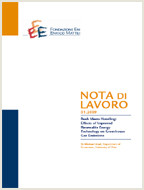Energy Prices and the Real Exchange Rate of Commodity-Exporting Countries

21.11.2013
Magali Dauvin
C33, F31, 013, Q43
Energy Prices, Terms-of-Trade, Exchange Rate, Commodity-Exporting Countries, Panel Cointegration, Nonlinear Model, PSTR
Energy: Resources and Markets
Giuseppe Sammarco
This paper investigates the relationship between energy prices and the real effective exchange rate of commodity-exporting countries. We consider two sets of countries: 10 energy-exporting and 23 non-fuel commodity-exporting countries over the period 1980-2011. Estimating a panel cointegrating relationship between the real exchange rate and its fundamentals, we provide evidence for the existence of "energy currencies". Relying on the estimation of panel smooth transition regression (PSTR) models, we show that there exists a certain threshold beyond which the real effective exchange rate of both energy and commodity exporters reacts to oil prices, through the terms-of-trade. More specifically, when oil price variations are low, the real effective exchange rates are not determined by terms-of-trade but by other usual fundamentals Nevertheless, when the oil market is highly volatile, currencies follow an "oil currency" regime, terms-of-trade becoming an important driver of the real exchange rate.
***
Suggested citation: Dauvin, M., (2013), Energy Prices and the Real Exchange Rate of Commodity-Exporting Countries’, Nota di Lavoro 102.2013, Milan, Italy: Fondazione Eni Enrico Mattei.
